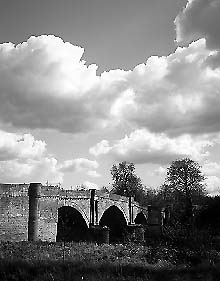
No. But Agfa did, and it worked.
Agfa Scala 200 is the most oddball innovation you can imagine. While the survival of the very slow Dia-Direct monochrome slide film could be understood - it had a specific use in some technical fields - the research and manufacturing effort needed to create a 1990s version of this 1950s phenomenon would normally rule out a replacement.
Yet Agfa did all this, and put Scala on the market in 35mm and rollfilm form, with a single dedicated processing line for each country. In Britain, that is Joe's Basement in Wardour Street, Soho, London. Nowhere else. That alone places this film firmly in one market - London advertising campaign and above-the-line corporate illustration.
For Joe's it will be a new experience; they never positioned themselves as a mail order lab, and their territory was well-defined by the readership of the British Journal of Photography and the Association of Photographers' Image magazine. Hence our own readers, distributed throughout the world and far from concentrated in the metropolis, may not have the same familiarity with Joe's Basement as Agfa's target user.
Joe's will just have to get used to a high volume of mail order work now they have Scala. There�s no way this film is going to be ignored by the wider world.
It must not however be confused with negative films like Ilford�s XP-2. Its ISO 'range' is not flexible and its latitude at any given push setting is pretty tight. Exposure needs to be at least as accurate as you would use for Fujichrome Velvia.
Scala's unique points are its exceptionally fine grain and high sharpness, rich maximum density and extended tonal range combined with very high speed for a reversal film.

This shot was taken on my old Leica with 20mm Russian lens and a yellow filter. Because Scala has very high red sensitivity, a yellow is enough to yield a strong sky.
A mono image has a far thinner emulsion than any multilayer slide film, and real silver grain is very different in structure from the masses bands of dye clouds which go to make up an E6 slide. Scala images have the same graphic quality and high microcontrast which you get from a perfect mono print off FP4.
The reason you might want to use Scala is that a 36 exposure roll can yield 36 final images at no further expense. If your lighting and exposure, use of filters and composition are all perfect when you press the button, Scala yield an image which is first-generation and needs no enlarging. There is no printing process to degrade it; it can be scanned directly for reproduction, or projected with considerable impact.

This rollfilm shot taken by Les McLean, using spot metering for accuracy, is ideal for printing to superb quality on R-type or Ilfochrome gloss papers - and for reproduction by direct scanning.
Scala can also be printed using Ilfochrome or R-Type paper and promises wonderful results with high gloss materials. Finally, it can be toned for special effects as a strip or roll, in small quantities of chemicals, a process which is very expensive with large hand prints.

This is a Scala picture taken in sidelight with a bright sky, entirely without a filter. The level of sky and cloud contrast and detail is remarkable under these conditions.
This improves Scala�s balance for most subjects, and reduces filter factor of yellow, orange and red filters. These can produce some of the most attractive results with monochrome reversal, but with Scala you never really get the dead-black sky which a red filter produced with Dia-Direct. A 2X yellow filter seems to be all you need for strong but realistic result.
One 35mm roll was accidentally exposed at 100 instead of 200 speed. The overexposure was very noticeable. Les McLean, with his usual critical attention to metering, turned in a lovely 120 roll. I surprised myself by finishing a 120 roll off in very poor conditions, only to find that Scala had transformed an overcast day entirely. The pictures looked far, far better than any colour slide.
Scala scans well for reproduction and is a perfect medium for copying black and white prints for distribution. Picture agencies will probably start using it for this purpose, as it introduces no colour casts and is very faithful to the original tonal scale.
This brings me back to the intro; who would introduce such a film? A company which saw a need, and I think the 'need' is actually in the field of archiving and distributing monochrome images without the expense and bulk of prints. The creative use is a spin-off, and very welcome.